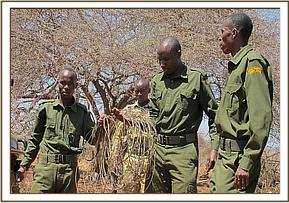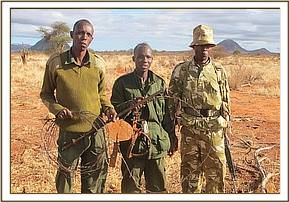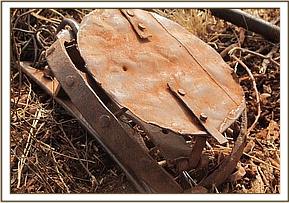The Faru (Burra) Anti-Poaching Unit led by Moses Simuyu Wakesa, operates within Southern Sector of Tsavo and Ranch lands, including the Lion Hill/Manyani stretch of Tsavo East National Park which is an area that is predominentlly open grasslands, with few acacia trees standing in isolation
The Faru (Burra) Anti-Poaching Unit led by Moses Simuyu Wakesa, operates within Southern Sector of Tsavo and Ranch lands, including the Lion Hill/Manyani stretch of Tsavo East National Park which is an area that is predominentlly open grasslands, with few acacia trees standing in isolation. This area is also a vulnerable habitat requiring constant attention from the DSWT and the KWS rangers. Regular patrols and monitoring is especially important because wildlife numbers here tend to be high including buffaloes, elephants, giraffes, impalas and zebras, waterbuck and gazelles, which all flock to the water breathers along the pipeline. Associated predator life (lions, Leopards and cheetahs) can also be easily found here in good numbers.


With the presence of three infrastructures running through our areas of operation, which include the power line, water pipeline and the petroleum pipeline, poachers have taken great advantage and with a lot of cunning they sneak into the Park to set up snares and traps and then slip out into the nearby community settlements undetected with their loot. They target various kinds of animals depending on their objective. Our team is constantly retrieving snares targeting game meat, but there are also crafty and devastating snares set targeting the big game, primarily elephants for their ivory.


Recently we located some of these leathal traps set for elephants and it was hard to imagine the unspeakable agony and damage they would have caused had they gone undetected by our patrolling efforts. The ‘Gin Trap’ as it is named is one such device, which is made from steel and is carefully laid down on a busy elephant path. Its two interlocking jaws are left spread (with the help of another fairly long steel rod). The entire system has to be then firmly fastened on a nearby tree stump by woven copper wire, which creates a perfect animal capture mechanisim that would have snapped closed on an unsuspecting animal.


Another find was strands of winch steel cable interwoven for added strength - clearly targeting a mega herbivore - and judging by the location it was set - specifically an elephant. This was fastened on a nearly big Acacia tortilis tree by brand new fastening bolts. In one incident this was associated with a carefully concealed pit trap right at the base of the tree. An unsuspecting elephant in search of shade from the midday heat would very easily step into this, trigger the stone, which is hoisted up a tree branch by the attached wire which would trigger the entire slip-knot system into action. Thankfully the patrol team located this and was able to dismantal and remove it in time so that an innocent jumbo's life was not terminated this horrific way.




By Team Leader Moses Simuyu Wakesa